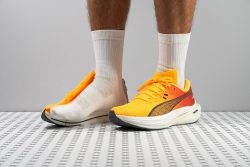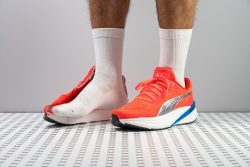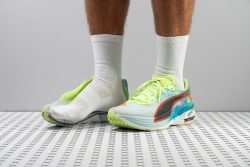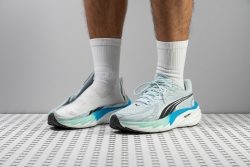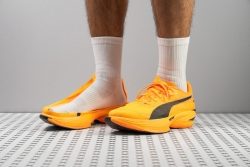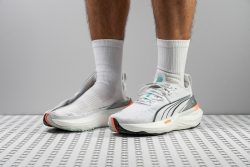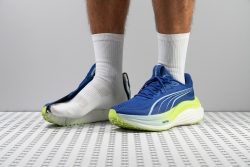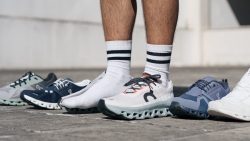7 Best PUMA Running Shoes in 2025
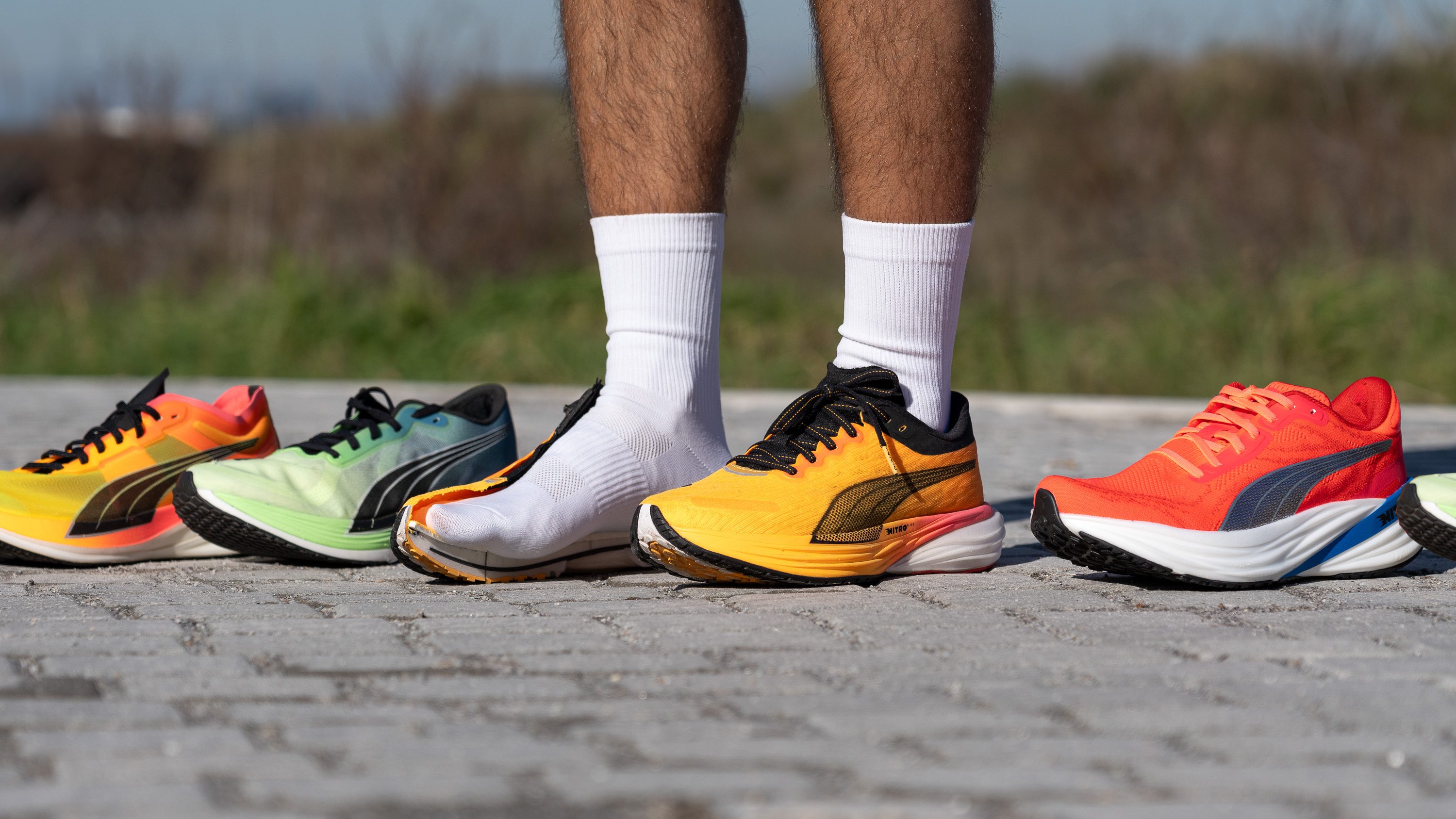
We buy shoes ourselves. We earn commissions when you buy through us, at no extra cost. Why trust us
The cat didn’t come to play. PUMA is lesser known than other brands in the running world, but it sure isn’t lesser when it comes to performance. Whether it’s on the road, trail, daily training, or racing, it’s going great guns.
And we say this because we’ve examined them ourselves through our independent shoe testing lab. Moreover, we tested them out on our feet and during our runs. We didn't let any facts or features pass by without us noticing and commenting about them.
As a result, we selected the real greatest running shoes from PUMA in different categories.
How we test PUMA running shoes
We love to go through the nooks and crannies of each PUMA shoe we try and to do so, we keenly and thoroughly carry out the following:
- Purchase the PUMA shoes we test with our own money to avoid brand bias and loyalty
- We run in each shoe for 30-50 miles in various terrain and conditions.
- In our lab, we cut each shoe open with our saw, and measure all parts of it with our calipers, durometers, scales, etc. to give you concrete data. We also place these data in comparison with the average values, to make the results more contextual and easier to describe.
Best PUMA running shoes overall
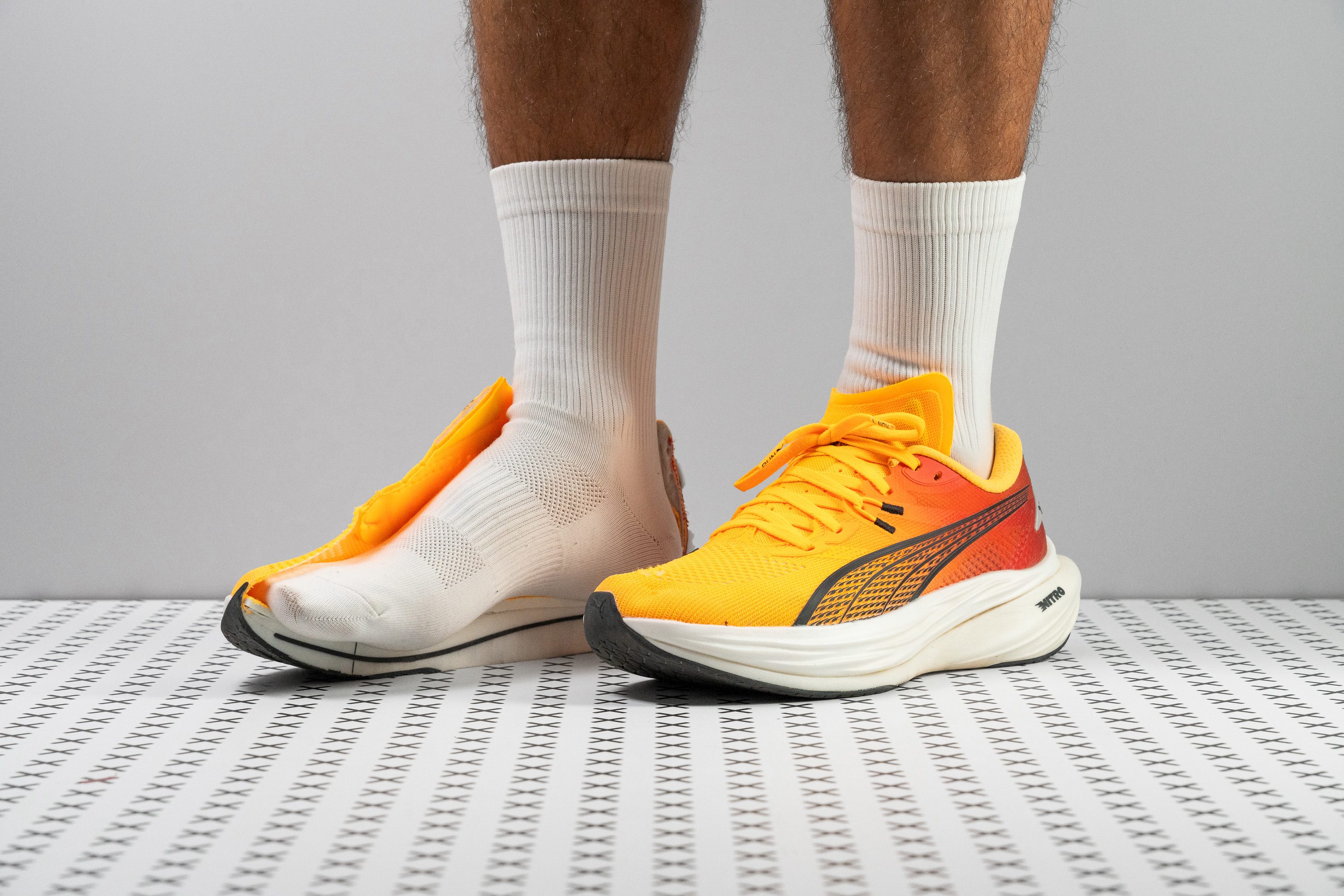

























































What makes it the best?
We found a super trainer that graced our runs with insane responsiveness, a foam that spoiled our feet, and an outsole that grips like there’s no tomorrow. Unbeatable in the all-rounder game, the Deviate Nitro 3 is our top PUMA running shoe.
Housing a carbon PWRPLATE in the midsole, we felt the shoe’s consistent energy return in our runs! The lab backed this up, but it was our feet that cherished it the most. In our 30° bend test, it emerged 37.3% stiffer than average, explaining why we could push our boundaries with less effort.
Speed doesn’t come at the expense of comfort, as the soft yet responsive foam ensures our legs stay fresh and energized. We found a dual-density set-up with softer-than-average measurements of 19.0 HA and 18.0 HA, delivering silky-smooth strides.
Another highlight is the PUMAGRIP ATR outsole, clinging to the surface with such magnetic power. Our durometer reveals it’s 10.4% softer than average, explaining its unmatched traction even on wet roads.
However, its 9.5 oz (268g) weight feels way too bulky for race day. Those eager to set new personal bests should find another option.
Pros
- Exceptional grip on all surfaces
- Competitively priced
- Responsive carbon plate
- Adapts well to all paces
- Enhanced knit upper
- Ideal for tempo workouts
- Great at navigating tight turns
Cons
- Needs better energy return
- Minor increase in weight
- Ventilation could be better
- Narrow toebox
Best PUMA running shoes for daily running
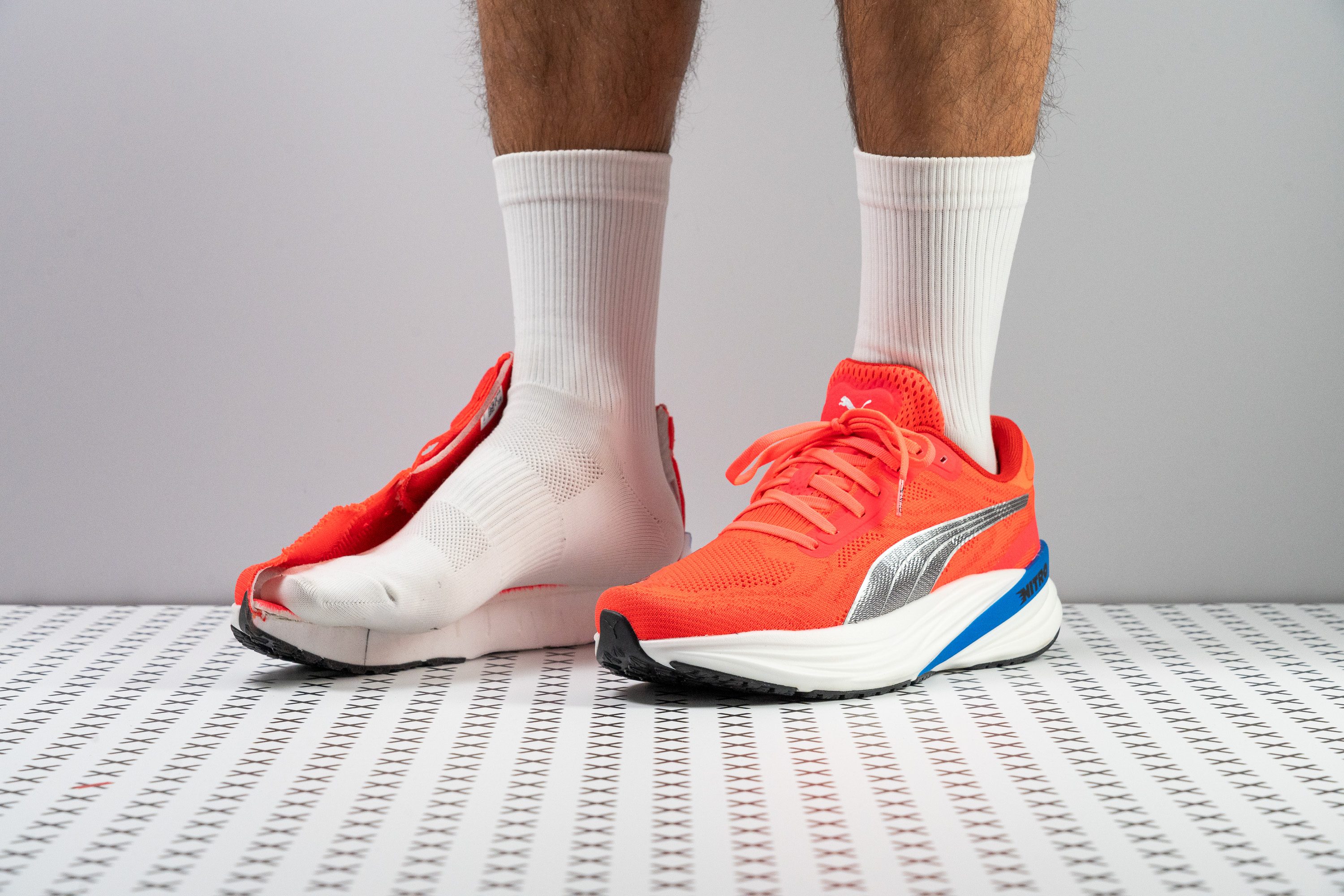



















































What makes it the best?
After rigorous lab tests and runs, Magnify Nitro 2 stood out as PUMA’s best daily trainer. We simply enjoyed its all-around performance—handling any run effortlessly regardless of pace or distance. It boasts an energetic ride and sails through all road conditions with its one-of-a-kind traction.
This trainer is the best companion to burn daily mileage with its pleasant in-shoe experience. We measured a generous 37.1/27.8 mm stack, which means it has exceptional cushioning for long miles. The PUMA Nitro midsole feels very responsive, offering a lot of bounce in our runs. It has a steady and comfortable feel, which led to zero instances of bottoming out. Our durometer confirms a balanced 19.3 HA measurement.
MN2 has a world-class PUMAGRIP outsole to boast, which translates to exceptional grip and durability in our experience. We trained on dirt roads, wet pavements, and even icy conditions, and it delivered top-notch traction. We have no worries about premature wear as PUMA provides a solid 4.2 mm of rubber vs. the 3.2 mm average.
However, its knitted upper feels like a sauna on summer days. With a low 2/5 rating on our breathability test, this trainer is better off in colder seasons.
Pros
- Secure grip
- Durable and comfortable upper
- Surprisingly stable despite its height
- Fantastic at gravel paths and dirt roads
- A fantastic all-rounder
- Ideal for long runs
- Good option for winter runs
Cons
- Lacks snap
- Could benefit from being slightly lighter
- The heel counter could be more durable
- Only for low-volume feet
Best PUMA shoes for running a marathon
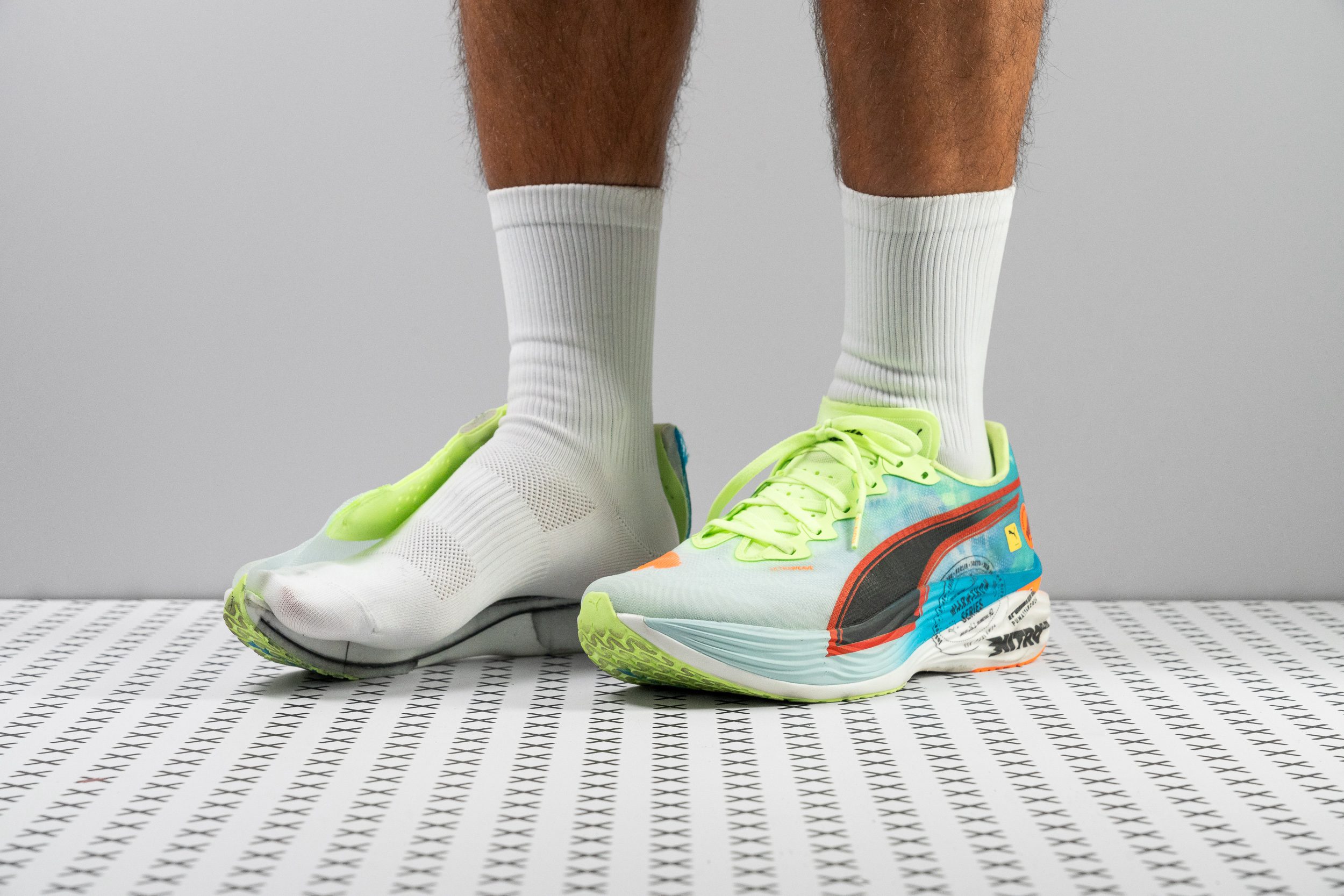





























































What makes it the best?
The PUMA Deviate Nitro Elite 3 redefines what it means to be a supershoe. It’s a light speedster with exceptional grip and deep, leg-saving cushioning. Our lab numbers and runs wholeheartedly agree that it’s our top PUMA marathon shoe.
The shoe feels insanely responsive in our runs and works wonders in short to long races. Its rocker geometry and stiff carbon plate launch us forward effortlessly. Our flex test confirms it’s 19.1% stiffer than average, explaining the pop of energy we experience. The midsole is composed of state-of-the-art Nitro Elite foam that feels exceptionally bouncy underfoot, scoring solid scores of 77.1% (heel) and 76.3% (forefoot) in our energy return test.
Speed doesn’t sacrifice comfort with its luscious heel rising to 39.2 mm. The midsole saves our legs from feeling tired and beaten up, backed up by above-average shock absorption levels of 147 SA in the heel and 124 SA in the forefoot. Despite its height, it feels ultra-light, and our scales agree with a 7.2 oz (240g) figure.
The PumaGrip rubber remarkably stands its ground! Testing for its traction, it returned a high friction score of 0.67, making it 42.6% grippier than average! At 2.6 mm, it's thicker than typical sub-2.0 mm racers, which helps prolong its life for marathon racing.
However, the shoe’s streamlined midsole makes it more susceptible to instability. Those in need of more pronounced support should look elsewhere.
Pros
- Superb Nitro Elite foam
- Breathable, lightweight upper
- Extremely responsive
- More affordable than most supershoes
- Outstanding grip
- Great comfort for a racer
- Major improvements from v2
- Fast, agile, race-ready performance
- Fantastic tongue
Cons
- Not the best for heel strikers
- Durability concerns
- Lacks stability for some runners
PUMA running shoes with the best traction
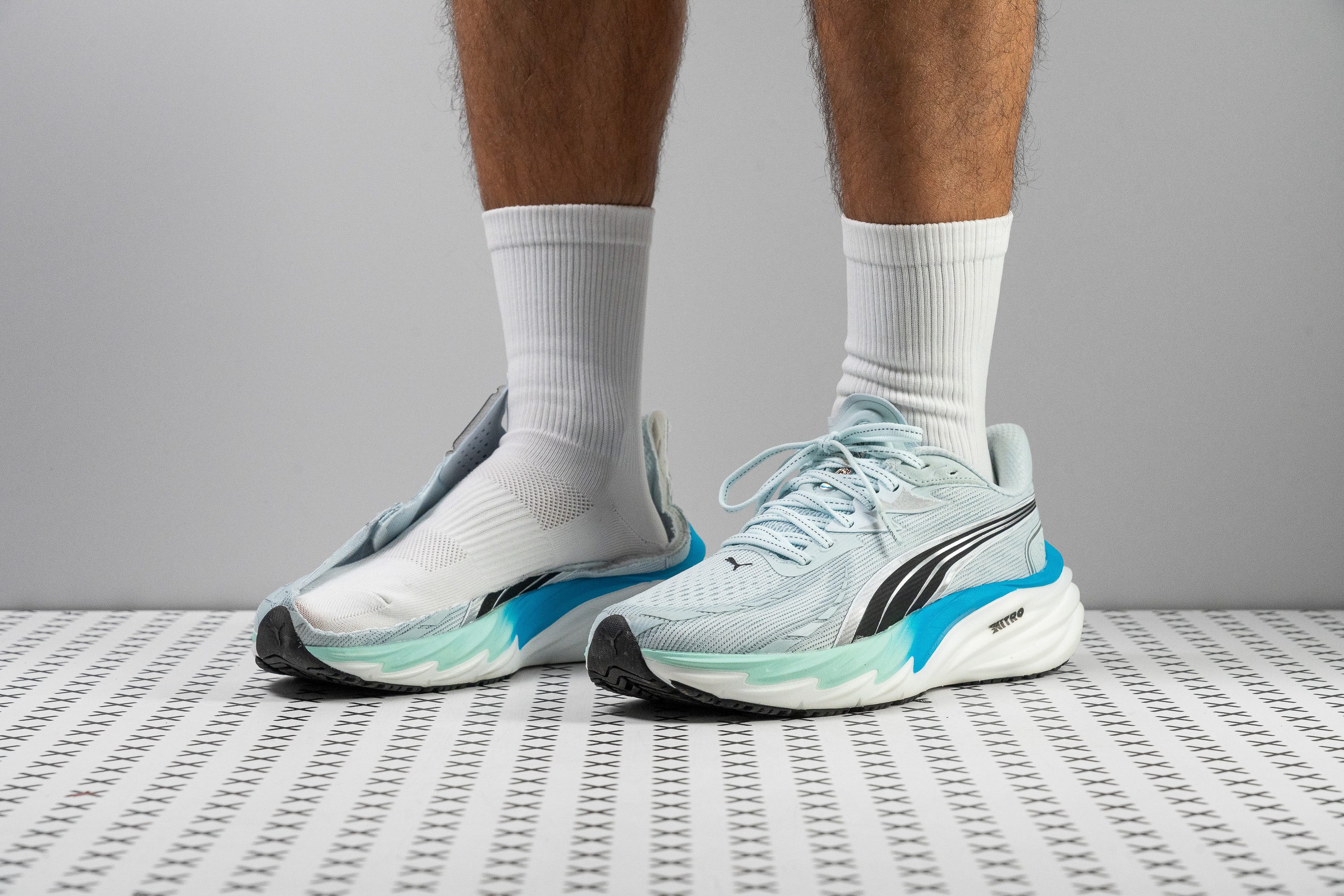












































What makes it the best?
With impressive scores across the board, the Velocity Nitro 4 not only proves its reliability in our runs but also exceeds expectations with its responsive cushioning and agile feel in a lightweight build. In our lab tests, its unwavering slip-resistance solidifies its position as the PUMA running shoe with the best traction.
PumaGrip, known for its remarkable bite on many surfaces, proves its effectiveness once more with an ultra-grippy 0.65 score in our wet-condition test, 38.3% above the average. During runs, it boasts its adhesive power even during rainy days and on sharp corners we tested.
Further boosting our nimbleness is its flexible midsole that gives a natural feel. Our bend test shows it’s remarkably 41.4% more pliable than average, making it versatile enough for walks and gym workouts.
Lightweight by feel and on our scale, it weighs only 7.9 oz (224g), making it 15.5% below the average running shoe. When we want to push the pace, Velocity Nitro 4 follows immediately. Despite being a daily trainer, it showed top-tier energy return scores of 67.5% in the heel and 74.2% in the forefoot, explaining why we never felt like our runs lacked life.
However, we discovered a narrow 71.6 mm toebox that may cause blistering and discomfort to wide-footed runners. Those who thrive in shoes with a more forgiving fit should try other options.
Pros
- Impressive energy return
- Lightweight and agile underfoot
- Superior traction from PumaGrip outsole
- Handles tempo efforts with ease
- Flexible and comfortable for everyday use
- Accurate real drop
- Natural-feeling, non-rockered design
- Balanced cushioning with some ground feel
- Looks really cool
Cons
- Not ideal for long runs
- Fit leans toward the narrow side
- Midsole becomes firmer in cold conditions
- Slight price increase
Best PUMA shoes for running 5K and 10K races
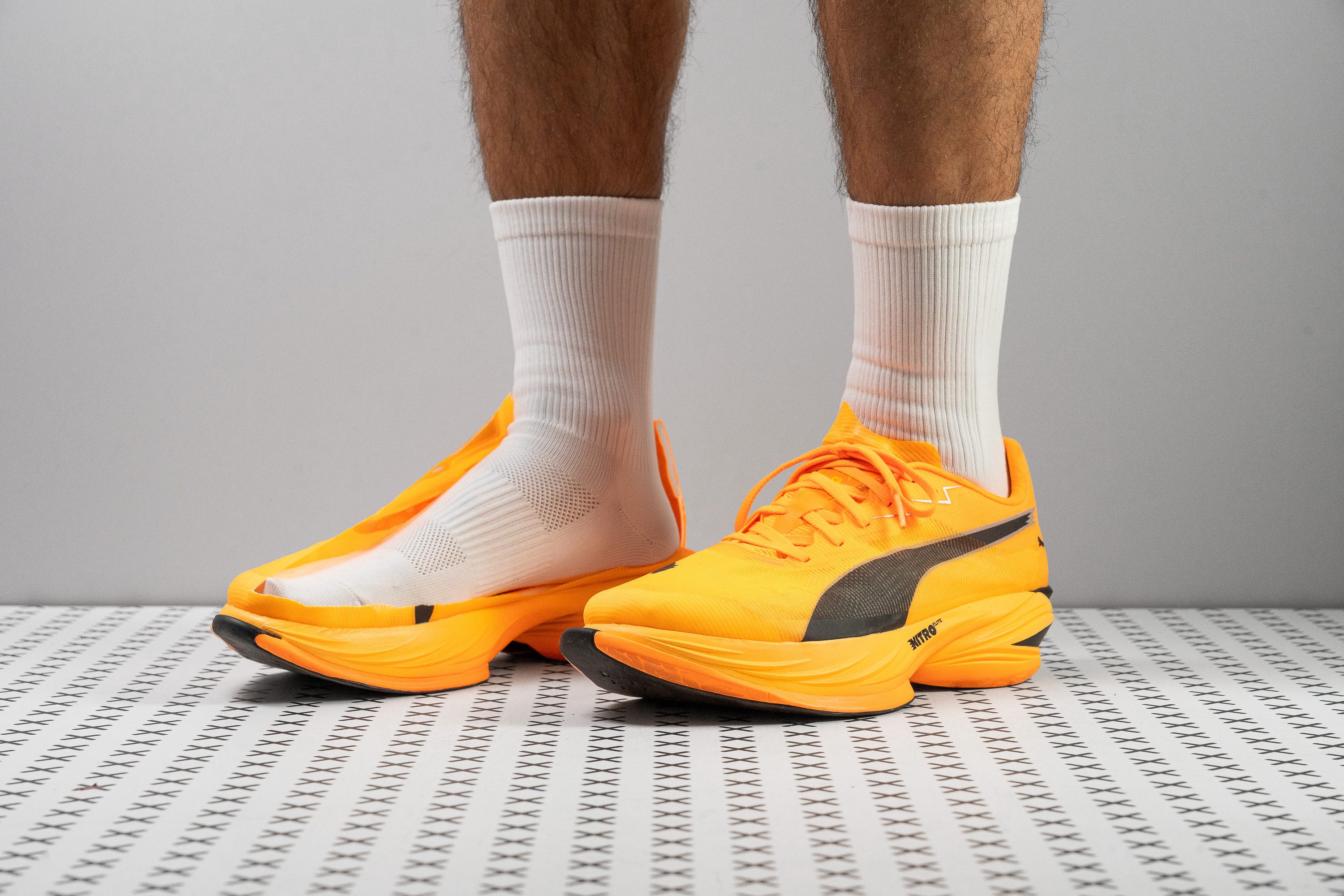


















































What makes it the best?
Highly competitive and daring on all fronts, Fast-R Nitro Elite 3 is a uniquely designed shoe that creates a wild and dynamic ride that isn't for the faint-hearted. Combined with its maximum joint protection, unmatched speed, and lightweight build, it’s the ultimate 5K/10K racer among PUMA running shoes we tested on foot and in the lab.
This racer's standout feature is its decoupled midsole and extended PWRPLATE, delivering a thrillingly fast experience alongside the energetic Nitro Elite foam. Our lab tests show the shoe is remarkably 52.0% stiffer than average, ensuring seamless and strong forward propulsion. Testing for the cushion’s energy return, we recorded top-tier scores of 80.4% in the heel and 82.6% in the forefoot!
Beneath lies a tower of plush foam that delivers a protective ride from miles 1 to the last. Our caliper reveals a solid 38.5/30.2 mm stack, with great shock absorption scores of 148/124 SA. This combination ensures lasting comfort and less stress on our joints.
This supershoe is a featherweight champion, tipping the scales to a mere 6.1 oz (173g)—much lighter than other supershoes (7.5 oz/214g).
If limited durability is a deal-breaker, better to look elsewhere. Our Dremel wrecked the shoe from the upper to the outsole, so it’s best to reserve this shoe for racing.
Pros
- Insanely fast and incredibly fun
- Exceptional energy return from A-TPU foam
- Premium Ultraweave upper
- Innovative extended plate design
- Perfect for 5K/10K
- Excellent shock absorption for long distances
- Includes two different lace types
- Reliable lockdown
- Huge weight reduction compared to version 2
Cons
- Higher price than before
- Extremely unstable
- Very limited durability
- Unsuitable for heel strikers
PUMA running shoes with the best stability
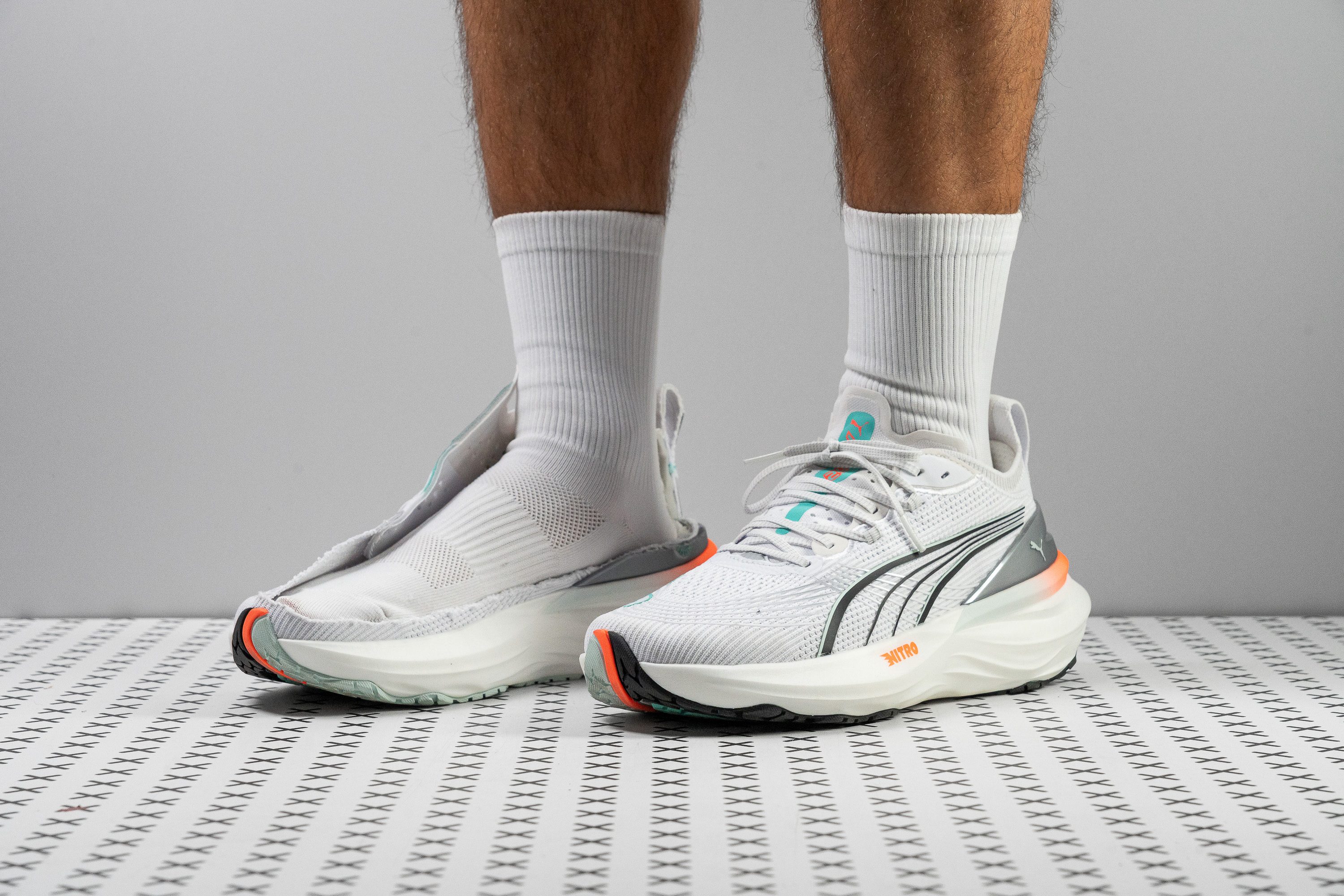











































What makes it the best?
We felt like we could run forever in the best stability PUMA running shoe: the ForeverRun Nitro 2. It exceptionally has a combination we rarely see in the lab—flexibility, responsiveness, and surefootedness into one. Plus, its PUMAGRIP enhances our control over a variety of surfaces!
The Run Guide System takes center stage in ForeverRun Nitro 2, featuring a plastic insert in the heel counter for steady landings. Moreover, it provides us with a massive landing base to find our balance securely. Our caliper verifies this with measurements of 121.3/97.6 mm, compared to the average of 114.3/90.7 mm.
ForeverRun Nitro 2 goes against traditional stability shoes with its bendable and bouncy midsole. In our flex test, it emerged 28.0% more pliable than average, making it comfortable for daily wear. Meanwhile, it feels very responsive underfoot thanks to the nitrogen-infused foam, proven by solid energy return scores of 60.5% (heel) and 63.6% (forefoot).
Even as we ran through slippery streets, we maintained graceful and confident strides thanks to the grippy PUMAGRIP outsole. Its 0.63 friction score in our traction test indicates a strong bite, which felt undeniable during testing.
However, it features a moderate stack that may disappoint runners seeking deep cushioning. Those who prefer more foam for longer distances should try alternatives.
Pros
- Breathable and comfortable knit upper
- Amazing traction with PumaGrip
- Fair price for its features
- Excellent stability
- Flexible build
- Good durability
- Well designed for heel strikers
- Extra-wide midsole for added support
- Good option for everyday life too
Cons
- Heavier than the previous version
- Rocker mainly benefits heel strikers
- Stability system could be a bit intrusive
- Not the best for wide feet
PUMA running shoes with the best shock absorption
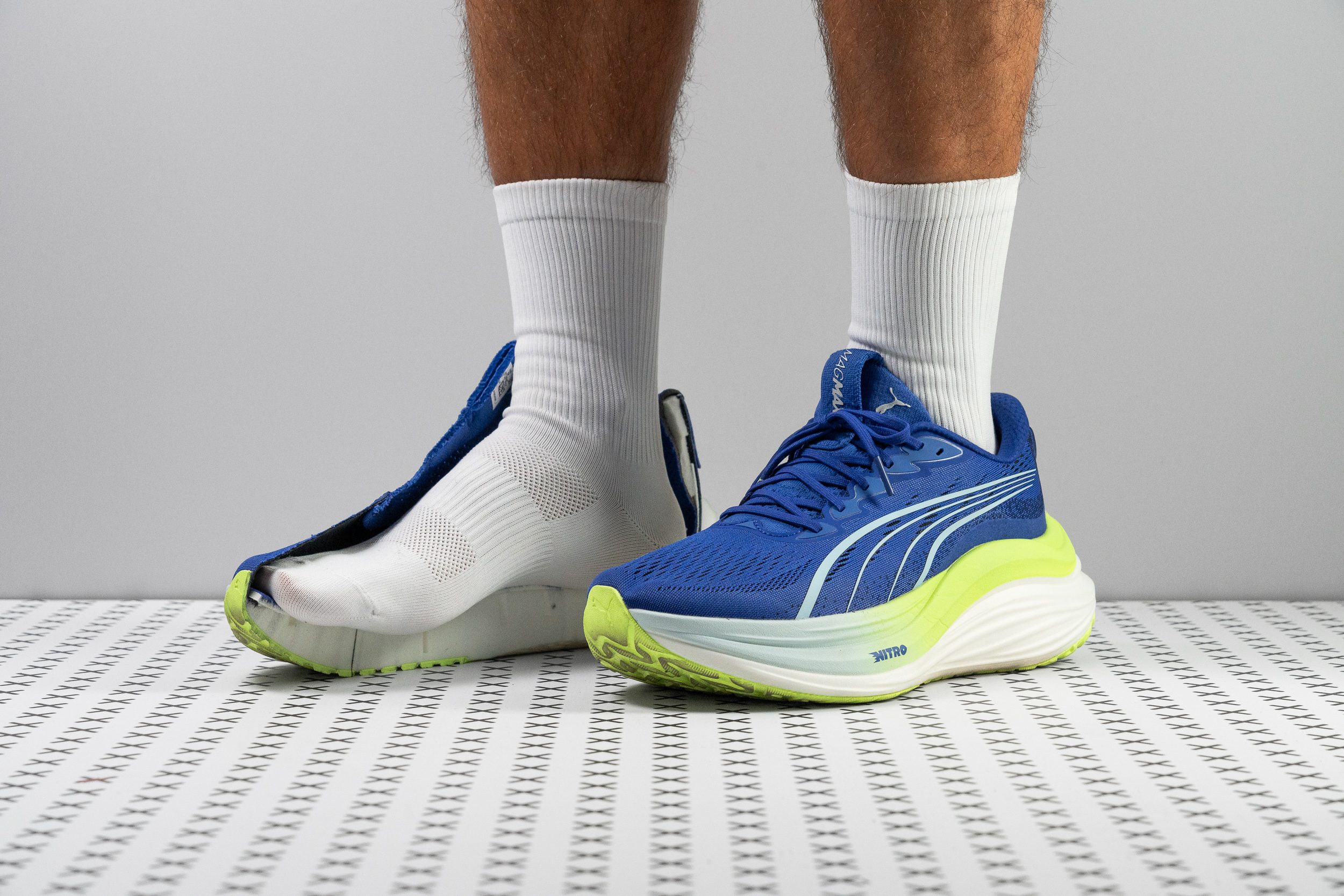























































What makes it the best?
The PUMA MagMax Nitro is all about exceeding boundaries: extra cushioning, extra support, and extra grip. We forgot about the ground with its mega stack and cruised comfortably on autopilot mode since the stable ride and outsole’s traction kept things in control. Among PUMA running shoes in the lab, MagMax Nitro offers elite shock absorption.
Wearing the shoe elevated us off the ground. Our caliper confirms a solid 42.9/33.3 mm under our feet, one of the highest we’ve encountered! It erased ground impact almost completely, confirmed by our shock absorption test with 148 SA in the heel and 139 SA in the forefoot. Very few shoes come close to the level of stress reduction it brings.
To our surprise, we never had the feeling of losing balance or toppling over. MagMax Nitro adds stiffness to its structure to keep us centered, evidenced by its 5/5 torsional rigidity score in our assessment. It also includes sidewalls and a massive sole flare for extra support. This trainer went all out on stability by even widening its base to a mega 126.9/105.8 mm, 12.6/15.1 mm more than average.
The PumaGrip’s adhesive force boosts our confidence and surefootedness by keeping us steady regardless of surface conditions. Our traction test confirms its gripping power is 30.4% stronger than average.
However, because of its size, it still lacks agility compared to other trainers. Those who prefer a speedy or weightless experience should check elsewhere.
Pros
- Endless cushioning
- Stretchy, comfortable tongue
- Outstanding traction
- Rock-solid stability
- Ideal for long-distance training
- Great for heel strikers
- Good value for being a supertrainer
Cons
- Heavier than most competitors
- Outsole shows fast wear
- Lacks agility
- Not enough energy return from Nitro

